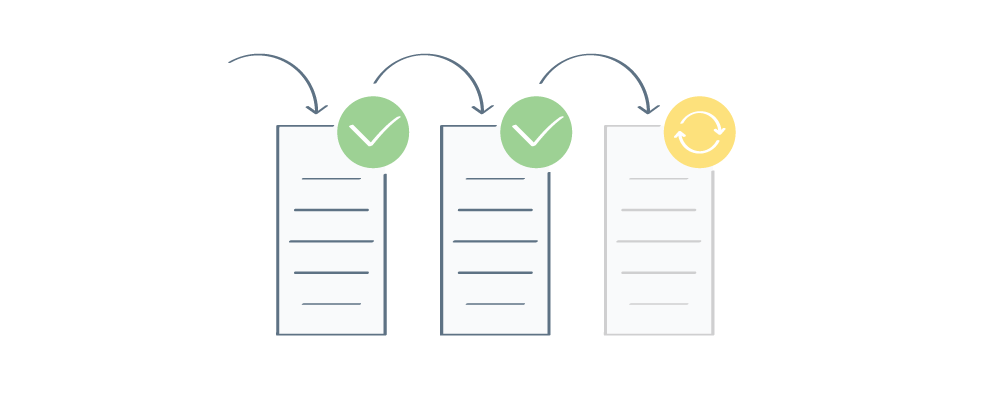Digital Kanban boards have become a groundbreaking invention for managing workflows in various industries. Even though there are three most common Kanban stages, digital Kanban boards allow you to do much more.
Now, that sounds like a mystery box you’d want to open for sure, right?
If we look into the history of Kanban boards and Kanban stages, the word Kanban is translated as “signboard” in Japanese. In the 1940s, Taiichi Ohno, an industrial engineer, introduced the concept. The idea behind it was to remove the inefficiencies occurring in Toyota’s production process.
Since then, various industries have adopted the idea for better workflow and production management.
Fun fact!
The Japanese used the Chinese characters “看板” to write Kanban. In which “看” means “to look” and “板” means “board.” Thus, it means to look at the board and translate it as a signboard or a billboard.
Read on to find out what is a Kanban board, its elements, work stages in Kanban, the best software to create a workflow with Kanban, and the benefits of having a workflow.
So, let’s begin!
What is a Kanban board?
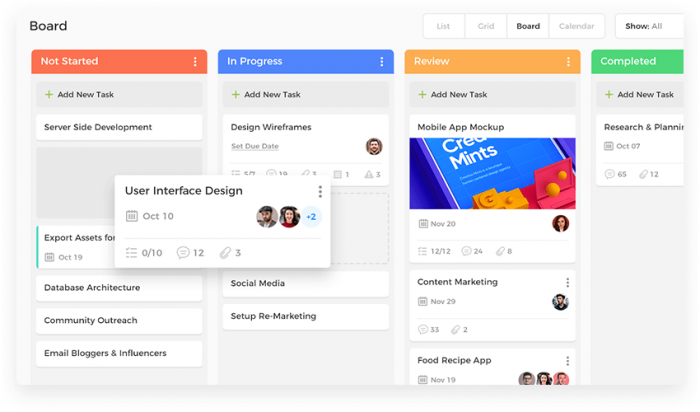
A Kanban is a visual tool designed to provide a complete picture of the current work status and increase team collaboration.
According to Agile Alliance,
“The Kanban Method is a means to design, manage, and improve flow systems for knowledge work. The method also allows organizations to start with their existing workflow and drive evolutionary change. They can do this by visualizing their workflow, limiting work in progress (WIP), and stopping starting and finishing.”
The Kanban Method gets its name from the use of Kanban – visual signaling mechanisms to control work in progress for intangible work products.
It helps project managers to simplify processes and track progress effectively. Thus, by visualizing everything in one place, your team will be able to stay in sync with each other.
Elements of a Kanban Board
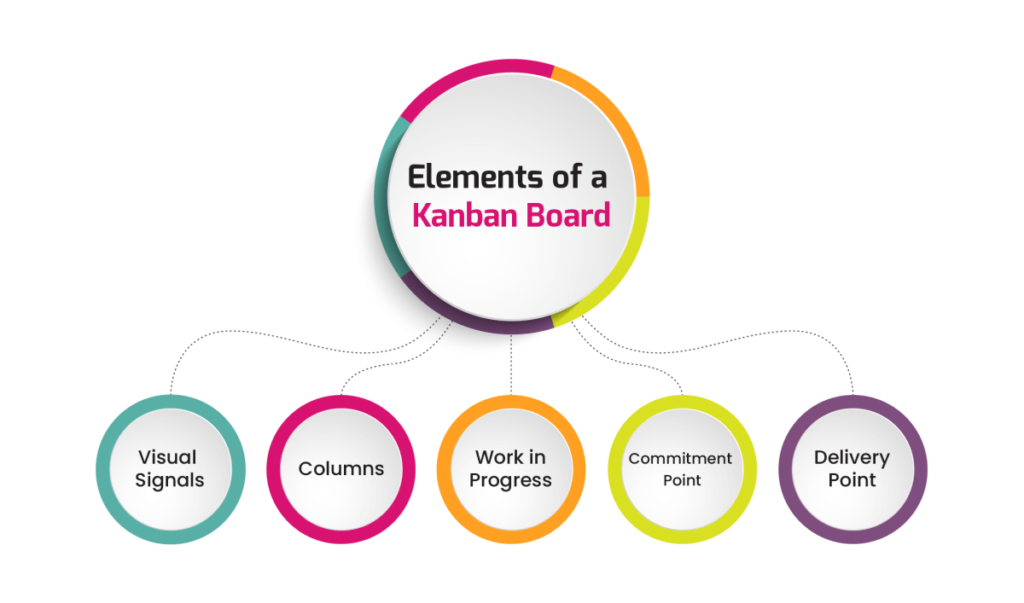
Typically, a Kanban board has the following elements:
1. Visual Signals
These are the stickies or tickets you use on your Kanban board. These are useful for stakeholders to have a picture of what the team is working on. Teams use them to write user stories on each card. Visual signals help the user understand which Kanban stage or Kanban phase the item is in.
2. Columns
There are typically three columns on a Kanban board. Each column represents a specific activity or a specific Kanban stage. When you combine these columns, they make the “workflow” of a Kanban board. We’ll see the workflow in detail in a bit.
3. Work in Progress
Work in progress represents the total limit of cards that can be displayed in one column. If you have a WIP of 3 cards, you can only display 3 cards for each column. This helps to avoid bottlenecks and clusters to keep a smooth workflow.
4. Commitment Point
It is the point where the team has put their ideas, and they pick the best of the ideas to start working on it.
5. Delivery Point
It is the point when the project is ready to be delivered and is in the hands of the customer.
Workflows and Work stages in Kanban
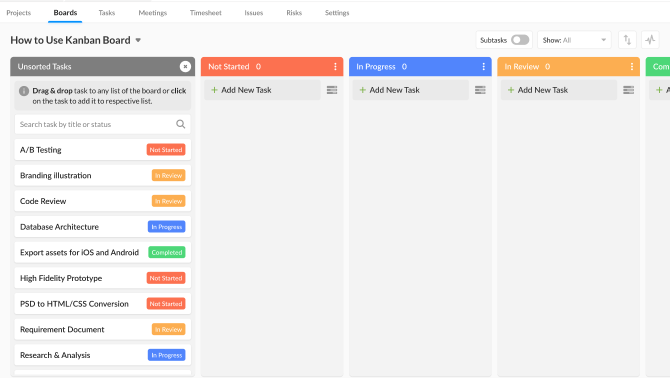
Well, the best part is that you can divide your workflow into various Kanban stages. This helps you have a clear picture of your ongoing and completed tasks. Typically, a Kanban workflow is divided into three main stages.
One thing to keep in mind is that a work item must go through all the work stages in a workflow, let’s see all of them one by one!
1. Stage 0
Start your work stages in Kanban with a clear board. This board is used to list all your tasks. You can add separate deadlines, status updates, priorities or assignees, etc. Once all your tasks are added, an automated Kanban board is generated.
Now, you move to stage 1 and customize each column to best suit your workflow.
2. Stage 1 – “To do list”
Typically, the first column in s traditional Is the to-do list column. This is one of the first Kanban phases where work is done, where you list all your ideas and tasks that are yet to be started. Thus, you can also name it as “not started.”
For example, you have an idea for a future marketing campaign but still need time to work on it. You can just stick to your “to-do” or “not started” list.
3. Stage 2 – “In progress”
The second one in the working Kanban stages is the “in progress” list. As the name suggests, in-progress lists all the projects currently in the pipeline and currently being worked on.
For example, when you start working on your marketing campaign, you can simply remove it from the to-do list and add it to the in-progress list.
4. Stage 3 – “Done”
The done or completed column shows all the tasks that are finished. Thus, you can simply drag it to the done column when you are done working on your marketing campaign. And with this, we are done with the stages or the four main Kanban phases.
REMEMBER! You can customize your workflow and add various columns like review, on-hold editing, etc., per your project’s demand.
How does the workflow function?
Kanban boards allow you to work in systematic order. You can’t move on to the next stage without completing the prior one. Thus, to do the task stated in the review column, you’ve to complete it and move from the progress stage.
This helps to identify any issues and bottlenecks in your project better. You can have full metrics on what caused the delay or error in the project with its workflow metrics.
How to create a workflow and work stages in Kanban?
The answer to that is simple!
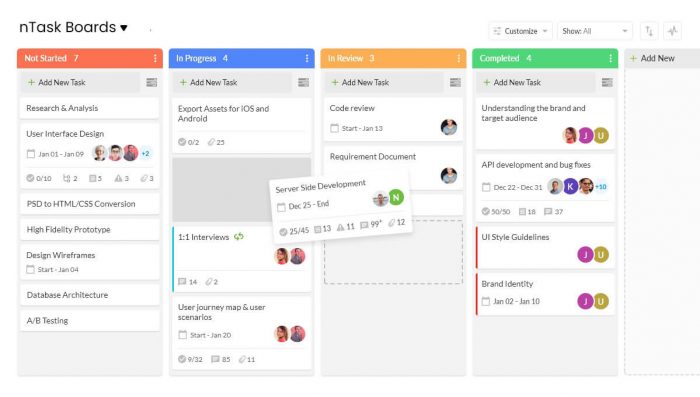
Use project management software for creating optimized Kanban board stages. nTask is an excellent software for you to hit the start with.
Here’s Why!
- It helps to enhance focus with smooth workflows.
- It helps teams to communicate efficiently within the same workplace.
- It optimizes your planning process status with its numerous features.
Some of its features that would change your project management game are:
- Link projects
- Visualize with Gantt charts
- Track time
- Personalize your workflow
- Assign tasks
- Add multiple status columns
- Set status color
- Use pre-built board templates
Featured Resources:
Video tutorial
Here is a short video on how you can create tasks on nTask’s Kanban board easily!
Create Task on Kanban Boad | nTask
Benefits of having a Workflow and Work stages in Kanban
1. Reduces errors
Having an organized workflow and work stages reduces the chances of making mistakes. The chances of missing out on a deadline or task are less as everything is displayed on the Kanban Board.
2. Improved collaboration
Kanban board stages for work allow teams to share and build stronger connections. Your whole team is sharing the same dashboard thus collaboration is enhanced. They can stay up to date with their tasks and the project’s progress.
3. Increased productivity
Since everything is managed on a single automated dashboard, your team doesn’t have to wait for approvals. They can get automated notifications and updates on their upcoming tasks. Thus, it helps to increase productivity and keep your team proactive.
4. Automated workflow
All project management software allows you to have an automated workflow. Thus, dividing your project into various work stages with Kanban will help you automate each task better. This will save a lot of time and mitigate errors.
5. Better management
With everything divided into separate stages, you will achieve better organization. You will know precisely how your project is supposed to get executed with no blind spots and hindrances.

-
Workflow Management With nTask Board
Manage documents, issues, projects, teams and tasks, all in one place. Sign up today!
- Get Started for Free
Wrap up!
So, that was easy to wrap your head around, right?
Kanban boards are an excellent aid for project managers to optimize their workflows and work stages. Team management and collaboration become tedious with an effective workflow.
However, it’s pivotal to use the best project management software. You don’t have to be alone, Rock when you got Kevin Hart with you.
Hope you liked the blog! Wish you good luck!

